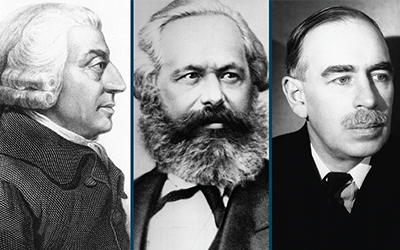9.3 Changing Economies
-
1 Opener
-
3 Articles
-
1 Video
-
4 Activities
-
1 Closer
Introduction
The Modern Revolution created the world we live in today. This world is very different from the world of 500 or 1,000 years ago, let alone 10,000 or 100,000 years ago. The connection of the four world zones allowed for the creation of a global network of exchange. Though this network was not built overnight, it emerged fairly quickly, and it increased the potential connections and diversity of connections for many members of the network. The result was an acceleration of both collective learning and innovation. Commerce was an important driver of change in this global network. Because commerce began to take on greater significance for many societies, a number of important thinkers began to ask questions about the nature of the exchange of goods, the nature of productivity and efficiency, and the interests of the individual and the state in business. All of this new inquiry gave birth to the discipline of economics. These economic thinkers, like the thinkers in any discipline, shared a set of concerns and questions but often came up with very different answers to those questions. The articulation of the ideas of capitalism and communism were the most influential economic ideas generated in the course of the Modern Revolution.
More about this lesson
- Describe accelerating global change and the factors that describe it.
- Describe how economies have developed and changed since the Industrial Revolution.
DQ Notebook
Preparation


Purpose
You revisit the unit driving question so that you stay focused on one of the key themes of the unit.
Process
Based on what you have learned so far in Unit 9, write you answers to the unit driving question using the DQ Notebook Worksheet that you downloaded in lesson 9.0. You should cite specific evidence to support your answers, and also reflect on how your thinking has changed since the beginning of the unit.
“Collective Learning” (Part 4)
Vocab Terms:
- collective learning
- diversity
- feedback cycle
- inequality
- network
Preparation


Summary
The Modern Revolution has given rise to a truly global community, and this revolution has accelerated the number and diversity of connections among people around the globe. This globalization in connectivity has led to an acceleration of collective learning. But the benefits of this acceleration have not been distributed equally. Different regions of the world enjoy more connections and a greater diversity in their connections. These differences are one of the factors contributing to differences in power and wealth among the world’s people.
Purpose
Like so many other features of the modern world, collective learning has also undergone a rapid acceleration. In this reading, you will consider the reasons why people in different parts of the world have not benefitted equally from the tremendous growth in collective learning. This should help you understand how some inequities have developed around the world as part of the social and moral implications of acceleration.
Process
Skimming for Gist
You learned in Unit 6 that one of the most important characteristics that distinguishes humans from other species is their ability to collectively learn. In other species knowledge gained in a lifetime of learning and experiences is always lost with the death of the individual. Because of language (and writing), humans have the ability to preserve an individual’s knowledge for future generations.
Understanding Content
By the end of the second close read, you should be able to answer the following questions:
- What are the primary reasons why collective learning has increased dramatically since the Industrial Revolution?
- Why are there vast differences in the connectedness, power, and wealth among individuals in the modern world?
Thinking Conceptually
At the end of the third close read, you should respond to the following questions: What are some specific examples of differences in the number of connections or diversity of connections that you see between different parts of the world? How do you explain these differences?
A Big History of Everything – H2
Vocab Terms:
- collective
- engine
- information
- modern
- network
Summary
A Big History of Everything – H2 (7:21)
Key Ideas
Purpose
1:07:13-1:14:31. This video clip will give you a short review of the major changes that occurred from the connection of the four world zones to the modern era. These connections are extremely important in understanding the Modern Revolution, and how industrialization and acceleration led to a transformation in how humans used energy and how that transformed economies.
Process
Preview
The Industrial Revolution led to the creation of machines that harnessed the power of the energy from the Big Bang and our Sun to transform our world and the way we live.
Key Ideas—Factual
Think about the following questions as you watch the video:
- How are “liquid highways” considered to be our first World Wide Web?
- How do metals brought by meteors; ancient plants; and water help to initiate the Industrial Revolution and thus accelerate human innovation?
- How do machines capture the power and energy of the Sun?
- How do our voices connect to the energy released in the Big Bang?
- How long did it take for human knowledge to double during the age of the steam engine? How long does it take for our knowledge to double now? By 2020?
Thinking Conceptually
Can you think of any other connections between the Big Bang, new chemical elements, the formation of our Solar System, or other thresholds and the Modern Revolution?
“Smith, Marx, and Keynes”
Vocab Terms:
- capitalism
- competition
- decision
- economics
- good
- wealth
Preparation


Summary
The acceleration accompanying the Modern Revolution can be seen in many areas of life including economics. In their quest to understand the role of economics in the Modern Revolution, scholars have developed the discipline of economics. Not all scholars have answered the key questions of economics in the same way, and the differences in approach to complex economic problems have led to conflict in the modern world, particularly in the twentieth century. The most significant conflict—the one between supporters of capitalism and supporters of communism—led to the Cold War and pitted the world’s two most powerful countries, the United States and the Soviet Union, in a 50-year ideological struggle.
Purpose
In this article, you’re introduced to the study of economics and the ideas of three important economists from the modern era: Adam Smith, Karl Marx, and John Maynard Keynes. This article will help you understand economics, which is important for understanding global exchange networks, as well as the questions that economists are interested in. This article also provides another disciplinary perspective on historical thinking and the questions we can ask about past events.
Process
Skimming for Gist
Commerce and exchange networks were critical drivers of the Modern Revolution. Understanding the exchange of goods and services and how people meet their material needs is the focus of a discipline known as economics. What rules should govern exchange between individuals? Should one’s government have a role in monitoring exchanges? Should the government have a role in job creation? These are some of the questions that economic thinkers ask, and they have not always agreed in their answers to these important questions.
Understanding Content
By the end of the second close read, you should be able to answer the following questions about Smith, Marx, and Keynes:
- How did Adam Smith define division of labor and self-interest, and why did he believe they were essential to a strong economy?
- Why did Marx object to capitalism and blame all of the problems of workers on this system?
- How does Smith’s idea of self-interest compare with Marx’s idea of competition?
- What role did Keynes believe a government should play in the economy?
- In your opinion, are Keynes’s ideas more similar to those of Marx or Smith?
Thinking Conceptually
At the end of the third close read, does this brief introduction to capitalism and communism give you any ideas about why capitalist economies were better at generating innovation than communist economies in the twentieth century?
This Threshold Today – The Modern Revolution
Preparation

Purpose
Once again, as we reach a new threshold, you’ll search for and read news articles that reveal connections between today’s world and a threshold of increasing complexity, in this case, Threshold 8: The Modern Revolution. The Modern Revolution created the world we live in, and understanding the impact of this threshold—both positive and negative—on our world today will help you better connect with the course material.
Practices
Reading, claim testing
As part of this activity, you’ll be reading news articles online. These will vary in difficulty and style, so, where possible, use the skills you’ve learned as part of the Three Close Reads process to help you better understand these texts. When searching for information online, you’ll also use claim testers to evaluate credibility of the sources you encounter.
Process
The Modern Revolution is the eighth major threshold of increasing complexity in this course. The acceleration of change in the last 250 years has been fast and furious, and the impact of acceleration can be seen all around us. One important impact of this acceleration is the increasing fragility of the biosphere. New technologies have altered human society and transformed our relationship with the biosphere. Scientists and professionals of all types study contemporary life and search for answers about how life has changed and what the future may hold for us.
At this point, your teacher may have you conduct online research to find news stories about the Modern Revolution. If not, feel free to use the links below as a starting point! Remember to closely evaluate the credibility of the sources you encounter by asking yourself the following questions:
- What person or group is behind the website where you found the article?
- Why are they sharing this information?
- What authority do the author and website have about the topic?
- How does the author’s perspective impact their argument?
- Can you find other sources that agree with the claims in this article?
As you carry out research for this class and others, it’s useful to document the sources that you come across and the information in them. Use the research cards provided to do just that. If you’re working on a Little Big History Project, you might do some research that relates to your topic and Threshold 8. These links can help you get started with your research:
Revising Investigation Writing: Sentence Starters Part 3
Preparation

Make sure you have your graded Investigation 8 essay (or another piece of your writing that was graded using the BHP Writing Rubric)
Purpose
You’ve examined and revised Investigation writing samples based on Claim and Focus, Analysis and Evidence, and Applying BHP Concepts from the BHP Writing Rubric, and you’ve peer-reviewed an essay. Now, it’s time for the ultimate task—revising your own work. In this final activity in the Investigation writing series, you’ll practice evaluating your own work with a critical eye. This can be quite challenging, as it’s often hard to tease out your own errors in writing. However, learning to analyze your own writing will help you be a better writer, not just in BHP, but in all your future writing endeavors.
Process
This activity is going to be nearly the same as the last Investigation writing activity. However, this time you’re going to review and revise your own Investigation 8 essay based on the BHP Writing Rubric Criteria A, B, and C. Although this might sound simple, it’s actually really hard to turn a critical eye on your own writing. As a way to make this a little less difficult, you’ll have yet another set of sentence starters to help you with your revisions.
First, review your graded essay, keeping the rubric Criteria A, B, and C in mind. Then, underline what you intended to be the major claim or thesis in the essay. Next, improve your thesis statement using one of the sentence starters provided. After that, circle anywhere you used texts as evidence, and then rewrite one of those sentences using one of the sentence starters provided. Finally, highlight anywhere you applied BHP concepts, and use one last sentence starter to improve any statements where BHP concepts were applied.
Do you think that in the future you might use the rubric to analyze your writing before submitting it to your teacher? Talk about this with your class.
Up next—Investigation 9! You’re well-prepared to write an excellent Investigation essay, given all you’ve done to improve your writing this year. Keep that in mind as you dive into the final Investigation in the course.
Investigation 9
Preparation



Investigation 9 Prompt: To what extent has the modern revolution been a positive or negative force?
Purpose
This Investigation serves as the final writing assessment for the course and will help give you a sense of the growth you’ve made throughout the course in understanding a range of texts and using evidence to support your ideas. Additionally, this Investigation asks you to explore the major changes of the Modern era to understand both the positive and negative impacts of Industrialization.
Process
Day 1
It’s time for it’s time for one last Investigation. This Investigation asks you to respond to the following question: To what extent has the Modern Revolution been a positive or a negative force? Remember that you responded to this Investigation prompt in Unit 1 but this time, you’ll have all the information you’ve learned throughout the course to help you answer the question.
First, your teacher will ask you to write down your conjectures—best guesses— about whether the Modern Revolution has been a positive or negative force. This is not a yes or no question. Think about whether the Modern Revolution—which has made our world more complex and interesting, as well as more fragile and dangerous—has led to positive or negative changes. In what ways have our networks have expanded? These could be related to technology, communication, resources. Does expansion always lead to good results?
You’ll have about 5-10 minutes to make notes and think about whether the Modern Revolution has had a good or bad impact.
Next, your teacher will either hand out or have you download the Investigation 9 Document Library. As you review each document, you’ll use the graphic organizer to take notes on sources and evaluate the trends of the Modern era.
Day 2
Now it’s time to write! You’ll develop a five- to six-paragraph essay arguing whether the Modern Revolution has been a positive or negative force. Remember to use information from the Investigation 9 Document Library along with BHP concepts and other information you’ve learned in this unit as evidence to support your argument or opposing point of view. It is also important that you cite the sources you use as evidence in your essay.
Investigation Writing Samples
Preparation

Purpose
In order to improve your writing skills, it is important to read examples—both good and bad—written by other people. Reviewing writing samples will help you develop and practice your own skills in order to better understand what makes for a strong essay.
Process
Your teacher will provide sample essays for this unit’s Investigation prompt and provide instructions for how you will use them to refine your writing skills. Whether you’re working with a high-level example or improving on a not-so-great essay, we recommend having the BHP Writing Rubric on hand to help better understand how you can improve your own writing. As you work to identify and improve upon aspects of a sample essay, you’ll also be developing your own historical writing skills!